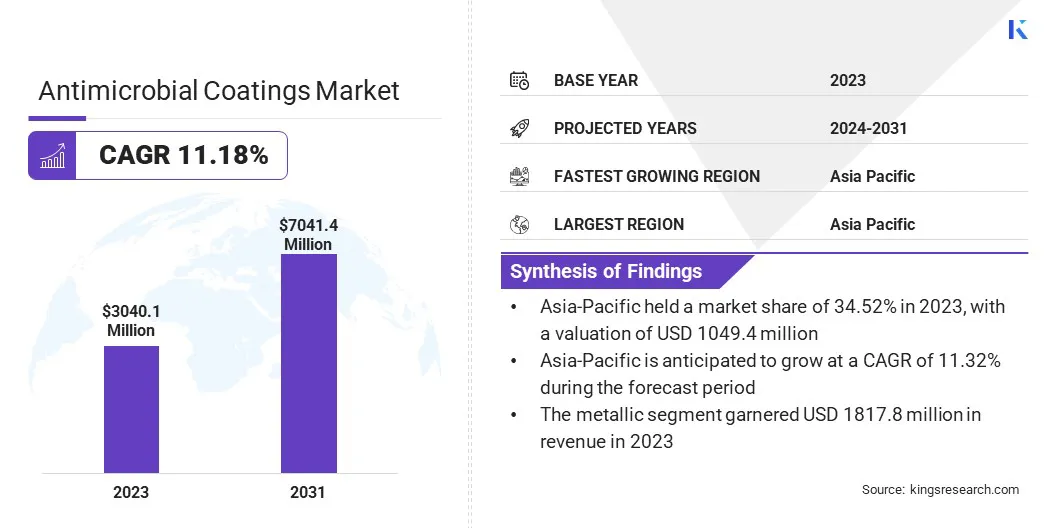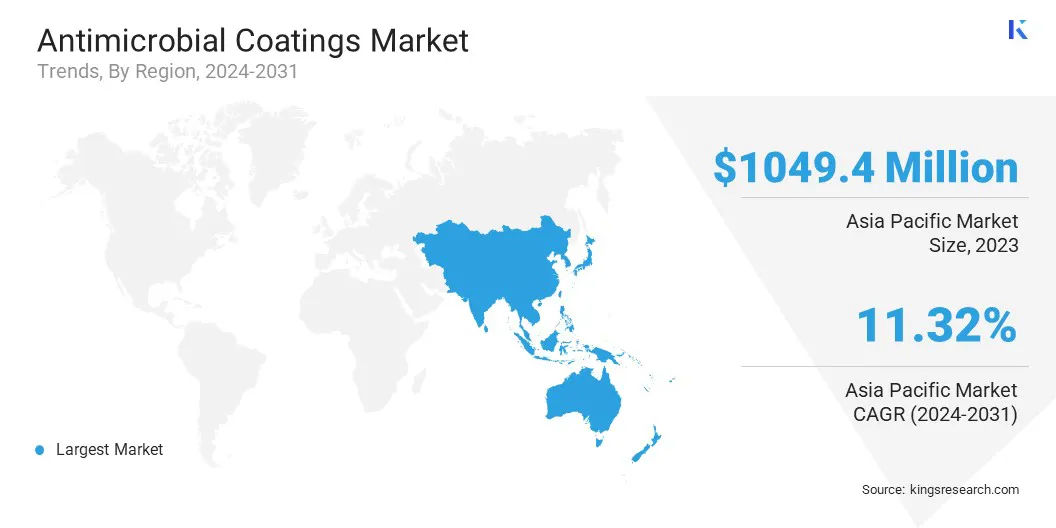Antimicrobial Coatings Market Size
The global antimicrobial coatings market size was valued at USD 3040.1 million in 2023 and is projected to grow from USD 3352.8 million in 2024 to USD 7041.4 million by 2031, exhibiting a CAGR of 11.18% during the forecast period. Increased awareness regarding hygiene and infection control, particularly in healthcare, public spaces, and food handling, has significantly driven the demand for antimicrobial coatings.
These coatings help reduce microbial contamination, enhancing safety and cleanliness in high-risk environments. In the scope of work, the report includes products offered by companies such as Akzo Nobel N.V, Axalta Coating Systems, LLC, The Sherwin-Williams Company, BASF, PPG Industries, Inc., dsm-firmenich, Sika AG, LANXESS, Burke Industrial Coatings, Apogee Enterprises, Inc., and others.
The market is evolving rapidly, driven by advancements in material sciences and growing demand for safer, cleaner surfaces. These coatings are integral to industries focused on hygiene, health, and safety. Their application enhances durability, prevents microbial growth, and offers long-term protection.
As industries seek sustainable solutions, the market is witnessing the introduction of innovative, eco-friendly coatings. Overall, antimicrobial coatings are transforming various sectors, making environments safer and more resistant to harmful microorganisms.
- In July 2024, Elementis expanded its NiSAT technology production in China to meet the growing demand for sustainable, eco-friendly solutions in the coatings market. This move supports the development of high-performance, environmentally responsible coatings, enhancing antimicrobial and safety features.
The antimicrobial coatings market refers to the industry focused on the development, production, and application of coatings that possess properties to inhibit or prevent the growth of harmful microorganisms, such as bacteria, fungi, and viruses. These coatings are designed to enhance the cleanliness, hygiene, and safety of surfaces, making them resistant to microbial contamination.
The market caters to a wide array of industries, including healthcare, construction, food processing, and consumer goods, offering solutions that improve durability and reduce the spread of infections. The growing focus on health, safety, and sustainability continues to drive the expansion of this market.

Analyst’s Review
The growing awareness regarding hygiene and infection control is driving the antimicrobial coatings market, especially in healthcare, public spaces, and food handling. As a result, companies are focusing on developing innovative, eco-friendly, and effective antimicrobial coatings that meet stringent safety standards.
- In February 2024, UAB and ICN2 researchers developed a bioinspired antimicrobial coating from mussel-secreted substances. This sustainable, scalable material combats pathogens like MRSA and E. coli, prevents antimicrobial resistance, and enhances healthcare safety by controlling infections in wet environments.
Many businesses are investing in research and development to enhance product performance, including better microbial resistance and longer-lasting effects. Strategic collaborations, localized production, and eco-label compliance are key strategies used by companies to cater to the rising demand for sustainable and high-performance coatings.
- In October 2024, Caracal and I2Pure unveiled a new line of antimicrobial products, targeting surgical preparation, skin antisepsis, wound care, and hand cleansing. By harnessing the power of molecular iodine technology, the collaboration aims to address the growing concerns of antimicrobial resistance. These advanced products are designed to provide superior protection against pathogens while offering a safer alternative to traditional antimicrobial agents.
Antimicrobial Coatings Market Growth Factors
The growing adoption of antimicrobial coatings across non-traditional industries, such as textiles, automotive, medical devices and electronics, is significantly expanding the market. These sectors are incorporating antimicrobial properties into clothing, vehicle interiors, and electronic devices to improve hygiene, durability, and safety.
This wider application of antimicrobial coatings is driving innovation and creating new opportunities for manufacturers to meet the evolving consumer needs for cleaner, safer, and longer-lasting products across diverse industries, further fueling market expansion.
- In April 2024, Onkos Surgical received FDA De Novo approval for its antibacterial-coated orthopedic implants. This innovation, designed to combat bacterial contamination, demonstrates the growing adoption of antimicrobial coatings in medical devices, expanding market potential in healthcare applications.
Antimicrobial resistance (AMR) presents a significant challenge for the antimicrobial coatings market. Overuse or improper application of coatings can lead to bacterial growth, rendering the coatings ineffective.
To address this, researchers and manufacturers are focusing on developing coatings with innovative mechanisms that only partly rely on traditional antimicrobial agents. Ensuring that the coatings maintain long-term effectiveness without contributing to AMR will be key to their future success in the market.
- In May 2024, Georgia Tech researchers developed an electrochemical process to create copper-coated, nanotextured stainless steel, offering an effective solution against bacterial contamination without contributing to antimicrobial resistance. This innovative approach addresses the growing AMR challenge in antimicrobial coatings.
Antimicrobial Coatings Industry Trends
Advancements in technology are driving significant progress in the antimicrobial coatings market, with a focus on developing more effective, durable, and eco-friendly solutions. Innovations in materials, such as the use of nanoparticles like graphene, silver, and copper, are enhancing the antimicrobial properties of coatings while reducing the risk of resistance.
Additionally, eco-conscious alternatives, including sustainable coatings, are gaining popularity. These technological advancements are encouraging broader adoption across various sectors, such as healthcare, textiles, automotive, medical devices, and electronics, by offering improved performance and environmental benefits.
- In September 2024, researchers at Chalmers University of Technology developed an advanced graphene-based antibacterial coating, capable of killing 99.99% of bacteria. This technology uses controlled magnetic fields to orient graphene, offering a sustainable solution for medical devices and combating antibiotic resistance.
Another growing trend in the antimicrobial coatings market is the shift toward eco-friendly solutions, where manufacturers are increasingly adopting bio-based and sustainable coatings. By incorporating natural ingredients such as plant extracts, these coatings offer effective protection against pathogens while meeting stringent environmental and regulatory standards.
This trend reflects a growing consumer and industry preference for sustainable alternatives, encouraging the development of antimicrobial coatings that are effective and environmentally responsible. This movement is expected to drive the market growth and innovation over the forecast period.
- In June 2023, the Luxembourg Institute of Science and Technology, alongside TDE, explored innovative bio-sourced antimicrobial coatings to address microbial growth challenges on the International Space Station (ISS). These coatings, free from heavy metals, aim to ensure sustainability and safety by using bio-based ingredients for space missions and closed environments.
Segmentation Analysis
The global market has been segmented based on type, end user, and geography.
By Type
Based on type, the market has been bifurcated into metallic and non-metallic. The metallic segment led the antimicrobial coatings market in 2023, reaching a valuation of USD 1817.8 million. The market for metallic antimicrobial coatings has witnessed significant growth due to their excellent bactericidal properties and durability, particularly in industries such as healthcare, automotive, and construction.
Metallic coatings, such as those based on silver, copper, and titanium dioxide, are primarily favored for their ability to effectively inhibit microbial growth on surfaces exposed to high levels of contamination. These coatings are widely adopted for medical devices, hospital surfaces, food packaging, and high-touch areas in public spaces.
The demand for metallic antimicrobial coatings is driven by their effectiveness in reducing infection risks, their long-lasting protection, and growing consumer awareness regarding hygiene and safety standards across various industries.
By End User
Based on end user, the market has been classified into healthcare, construction, protective clothing, food processing and packaging, HVAC system, transportation & automotive, and others. The HVAC system segment is poised for significant growth at a CAGR of 11.81% over the forecast period. The market for antimicrobial coatings in HVAC (Heating, Ventilation, and Air Conditioning) systems is expanding due to growing concerns regarding indoor air quality and the need to reduce the spread of harmful microorganisms.
These coatings are used for HVAC components such as air ducts, filters, and cooling coils to prevent microbial growth, improve air quality, and enhance system efficiency. With rising awareness of airborne diseases, the demand for antimicrobial coating-treated HVAC systems is surging, especially in healthcare, commercial, and residential buildings.
This trend is further fueled by the increased adoption of sustainable and eco-friendly coatings to create healthier indoor environments and improve overall system performance.
Antimicrobial Coatings Market Regional Analysis
Based on region, the global market has been classified into North America, Europe, Asia-Pacific, MEA, and Latin America.

The Asia-Pacific antimicrobial coatings market share stood at around 34.52% in 2023 in the global market, with a valuation of USD 1049.4 million. Asia-Pacific is a dominant region in the market, driven by rapid industrialization, increasing urbanization, and rising awareness regarding maintaining hygiene standards across various sectors.
The region's booming construction, healthcare, and automotive industries are major contributors to the growing demand for antimicrobial coatings, particularly in China, Japan, and India. Additionally, the strong emphasis on infrastructure development and a high focus on indoor air quality and public health, is boosting the adoption of antimicrobial coatings.
The region's thriving manufacturing capabilities and the increasing preference for eco-friendly and sustainable solutions further enhance its position as a leader in the global market.
Europe is poised for significant growth over the forecast period at a CAGR of 11.27%. Europe is emerging as a fast-growing region in the antimicrobial coatings market, driven by stringent regulations, rising consumer awareness, and a robust focus on sustainability. The region's healthcare, automotive, and construction sectors are actively adopting antimicrobial coatings to ensure hygiene and safety.
Increasing government initiatives promoting the use of eco-friendly and innovative solutions are also fueling market growth. Additionally, the demand for antimicrobial coatings is expanding due to Europe’s aging population, heightened concerns about healthcare-acquired infections, and the growing need for sustainable materials in industries. This, combined with advanced research and development, positions Europe as a rapidly evolving market.
Competitive Landscape
The global antimicrobial coatings market report provides valuable insights with an emphasis on the fragmented nature of the industry. Prominent players are focusing on several key business strategies such as partnerships, mergers and acquisitions, product innovations, and joint ventures to expand their product portfolio and increase their market shares across different regions.
Strategic initiatives, including investments in R&D activities, the establishment of new manufacturing facilities, and supply chain optimization, could create new opportunities for the market growth.
List of Key Companies in Antimicrobial Coatings Market
- Akzo Nobel N.V
- Axalta Coating Systems, LLC
- The Sherwin-Williams Company
- BASF
- PPG Industries, Inc.
- dsm-firmenich
- Sika AG
- LANXESS
- Burke Industrial Coatings
- Apogee Enterprises, Inc
Key Industry Developments
- May 2024 (Partnership): Nanosono, in collaboration with Nirlat, introduced AQUANIR ACTIVE SHIELD, an advanced acrylic paint capable of eliminating up to 99.99% of bacteria, viruses, and molds within hours. Currently used at Hillel Yaffe Medical Center, this product is set for broader use across the facility. The partnership is expected to drive innovation in antimicrobial solutions.
- June 2024 (Launch): NEI Corporation introduced NANOMYTE AM-100EC, a micron-thick antimicrobial coating offering easy-to-clean properties. Ideal for high-touch surfaces like plastics, metals, and ceramics, it is highly effective in industries with stringent hygiene needs. The coating shows superior abrasion resistance and a 99.99% reduction in E. coli, making it suitable for healthcare, food service, and public transportation applications.
The global antimicrobial coatings market has been segmented:
By Type
- Metallic
- Silver
- Copper
- Titanium Dioxide
- Others
- Non-metallic
By End User
- Healthcare
- Construction
- Protective clothing
- Food processing and packaging
- HVAC System
- Transportation & Automotive
- Others
By Region
- North America
- Europe
- France
- UK
- Spain
- Germany
- Italy
- Russia
- Rest of Europe
- Asia-Pacific
- China
- Japan
- India
- South Korea
- Rest of Asia-Pacific
- Middle East & Africa
- GCC
- North Africa
- South Africa
- Rest of Middle East & Africa
- Latin America
- Brazil
- Argentina
- Rest of Latin America


